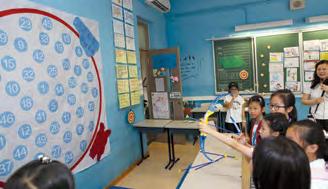19
Thematic Integration Learning in True Light The objectives of the Thematic Integration Learning Programme are of a wide range, from enhancing students’ learning motivation to fostering their generic skills and providing them with the opportunities to apply knowledge and skills they have learnt from different subjects. It has always been a major event of the year for our students, their parents and the teachers. Teachers of all subjects are involved to design, organize and conduct the whole programme. The theme for the school year 2018-2019 is titled “The energy saving crews”. In general, the choice of themes is usually discussed and determined by the Academic Department. Then a range of topics relevant to the theme are planned for learning and teaching in different subject panels. Different frameworks of learning, designed with engaging learning contents, are finally worked out for learners at various class levels. These all aim to enhance students’ knowledge on the topics and foster their generic skills across subjects. The climax of the programme comes to the Thematic Integration Activity Day, intended for providing an exciting context for students to apply the knowledge and skills they have learnt in the corresponding lessons of various subjects. Primary 1-4 students are grouped into small teams to take part in a competition in which they play educational games and finish learning tasks designed by our primary 5 and 6 students under the guidance of the teachers. The Thematic Integrated Activity Day is one of the yearly mass learning programmes that bring a lot of fun and unforgettable memories to the whole school. Behind our lovely students’ happy faces, their subject knowledge, generic skills and motivation to learn are all enhanced tremendously. (The Life-wide Learning Days scheduled for the school year 20192020 had to be cancelled due to the pandemic.)
Promote creativity and e-Learning in classrooms 中文科 資訊科技的運用,提升了同學對 中國語文課的學習興趣和整體教學效 能。本科的資訊科技教學除一般網站 資源、電子簡報和電子課本外,教師 更經常運用nearpod, Kahoot, socrative, Google form, Padlet, Flipgrid等教育電 腦程式或網上平台,準備教材及為學 生提供學習支援,例如:網上問答遊 戲、運用程式進行小組創作、運用電 子平台進行討論、即時評估及回饋、 課後網上鞏固練習。透過老師製作的 資訊科技教材和各種網上平台的運 用,為學生帶來有趣愉快的學習體 驗。
Attempts made through English Language learning Creativity, featuring one of the generic skills key to the development of a well-rounded education, has always been targeted as a major goal in our English Language curriculum. In the subject of English Language, students are regularly given various language production tasks that require them to invent ideas in situations that challenge their originality and problem-solving skills. While some of these are intended as imagined tasks, some exhibit authenticity and relevance to their everyday life or contexts embedded in course books or the story-lines in various readers. The development of thoughts and ideas is also enhanced through the extensive use of organisers, such as mind-maps and story boards, in the process of brainstorming and collecting of ideas and thoughts. What is no less important is however the opportunities for students to present and express their thoughts, winning the assurance or appreciation from others while inviting comments or suggestions from
their peers, which activates further interactions for deep thoughts in the class. To address the learning targets afore-mentioned, the use of information technology can no doubt support and assist the processes of exploring and tapping ideas as well as compiling and presenting students’ own thoughts. The wide range of software or apps no doubt facilitates the implementation of the whole process of learning. The convenience brought by various e-tools in recording, editing and producing appealing presentation reports, trailers, audio-visual images and so on definitely enhances the quality as well as feasibility for the students’ work to be shared among in class and at the school.









